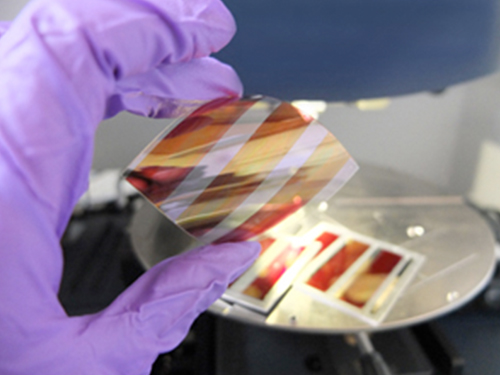FUNCTIONALITIES
Electronic Components
Smart labels and packaging
The use of electronic display labels to replace price tags on supermarket shelves is a promising business opportunity. These electronic labels have a low pixel density and consume little energy. They not only provide information on a product’s price and characteristics, but can also alert sales staff when stock needs to be replenished on the shelf. They can be attached directly to the product to provide consumers with real-time technical (performance) and commercial (discount granted, etc.) information. This type of label is considerably more expensive than a traditional label, but offers the advantage of being reusable, as well as the possibility of centralized updating of information for all items in the store.
Increasing the added value of a simple cardboard box is now a priority for major brands. Analysts note that TV advertising is losing its impact, while at the same time, consumers’ purchasing decisions are increasingly made in the store itself. Incorporating a flexible printed display into the packaging to provide information such as the list of ingredients, fat content or use-by date, can thus help to increase the perceived value of the product.
Another interesting market segment concerns so-called disposable electronics.
Professional multilayer ceramic capacitors
Made up of ceramic and metal layers, they feature complex shapes and advanced miniaturization. Mainly used in high value-added industrial sectors (aeronautics, aerospace, instrumentation, military, medical), they represent a $1 billion market.
Using traditional production technologies (strip casting, screen printing, thermo-compression), the introduction of direct ceramic and metal printing technologies reduces costs by a factor of two, while increasing performance by a factor of ten on half the capacitors in use today. With a French European leader in the manufacture of these components, France has taken a very serious lead in the application of direct printing technologies to the manufacture of ceramic multilayer capacitors, and should start production in the medium term.
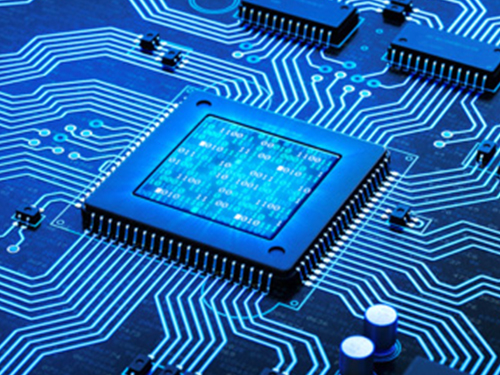
RFID Antennas
The market for labels and other electronic identifiers will exceed €15B by 2022. It is currently growing at almost 15% a year.
However, this development is conditional on a significant drop in the price of these tags. At present, RFID tags are viable for pallet identification, but too expensive for individual packaging. The development of printed electronics is an interesting avenue for significantly reducing these costs, thanks to high-volume production techniques.
Printing is already widely used to produce RFID antennas, but the production of complete RFID tags using printing techniques alone is still in its infancy. To produce a fully printed complex circuit that meets the current performance standards achieved by silicon technology, a large substrate area would be required. It will take a few more years of research (including work on low-cost, high-performance conductive inks) before they can be truly competitive with traditional RFID tags. Today, the standard process requires a hybrid approach in which the Silicon chip is positioned at very high speed and bonded to the antenna using conductive adhesives (pick&place process).
In addition to the logistics sector, other applications are already being studied, such as tele-badges for freeways, RFID-equipped loyalty cards for sending advertising, anti-counterfeiting marking, document marking to record and track files or works, security devices, passports, animal identification, etc.
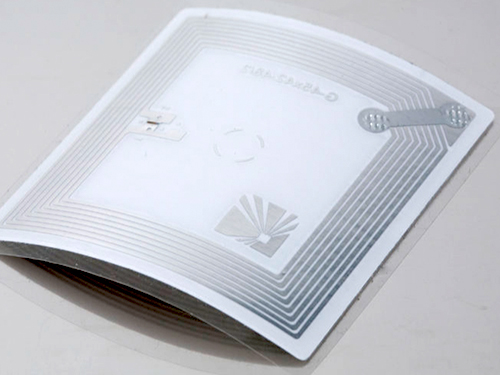
crédit photo SUPRATEC JMD
Oleds
The technology is based on the use of superimposed organic diodes which, once powered by an electric current, emit their own light by combining a charge-hole pair emitting a photon, unlike other types of display such as liquid crystal displays, which require backlighting on a network of optical valves..
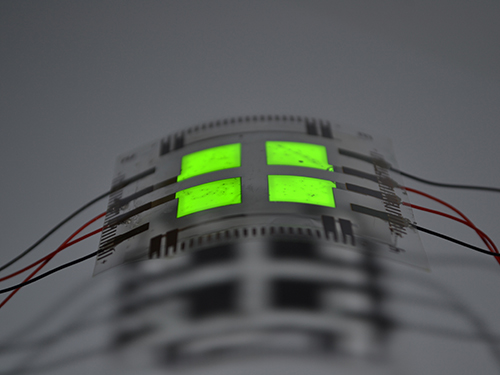
crédit photo CEA-LITEN
Oleds til belysning
Energikrevende belysningsteknologier (glødelamper, halogen) erstattes gradvis av ny omgivelsesbelysning som skapes direkte på vegger, tak, gardiner, vinduer eller andre overflater som kan integrere organiske lysdioder. Disse teknologiene integreres i økende grad i sikkerhetsbelysningssystemer i biler (for eksempel baklys på visse luksusbiler, noe som muliggjør innovativ og unik design).
Oleds for skjermer og displayer
OLED har allerede i stor grad erobret markedet for skjermer til alle små mobile enheter. De brukes nå i nettbrett, mobiltelefoner i toppklassen og dataskjermer på grunn av bedre bildekvalitet, kontrast og fargespekter enn LCD-skjermer. De er kompatible med fleksible substrater, men er fortsatt vanskelige å produsere på grunn av behovet for innkapslingssystemer med høy ytelse.
Batteries
They are structurally thin and flexible, can have widely varying form factors, can be integrated into disposable objects, but they still cost more than most conventional button cells, so their use is still limited to niche applications such as medical patches where their flat and extremely compact appearance is an essential factor.
Printed batteries (rechargeable cells) are now available on the market and can be used to power most printed applications. The manufacturing process is screen printing. The electrical voltage reaches 1.5 V in normal operation, making it possible to power the Internet of Things (IoT). New players are now introducing solutions based on materials derived from green chemistry, making it easier to solve the problem of the recyclability of intelligent objects containing embedded electronics.

crédit photo FEDRIGONI
Sensors
Unlike segments such as flat screens or RFID, there are still relatively few players in this field, given the development prospects in areas such as security and health (diagnostics and therapeutic applications).
Promising outlets for sensors printed on flexible substrates are emerging in the construction, protective clothing, military uniforms, packaging, robotics, aerospace and energy sectors. The ability to prepare them in highly variable form factors and surface finishes opens up a wide range of applications that would be inaccessible with silicon or inorganic equivalents (quartz, etc.). The main technological hurdle lies in the availability on the market of inks suitable for the production of these various devices, i.e. inks with sufficient sensitivity to detect particular substances or environmental conditions.
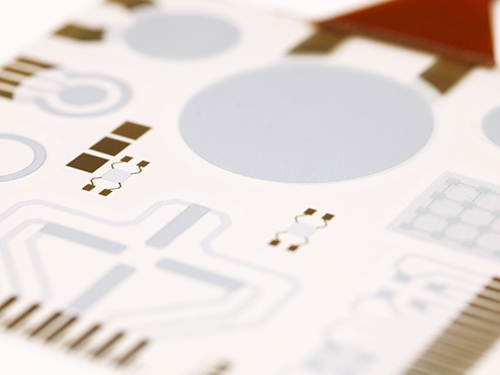
crédit photo ARKEMA
Intelligent systems
Combining several functionalities to carry out complex tasks autonomously is a response to the growing development of connected objects. What’s new is the use of flexible substrates to build complete systems that integrate measurement, logic and energy functions.
Organic electronics enable several functions to be integrated on a single substrate, enabling the design of integrated systems or intelligent sensors. These “systems on foil” take the form of flexible intelligent sensors that are inserted into textiles or bonded to surfaces, for applications that monitor the external environment (temperature, pressure, etc.) or health, and are compatible with label formats.
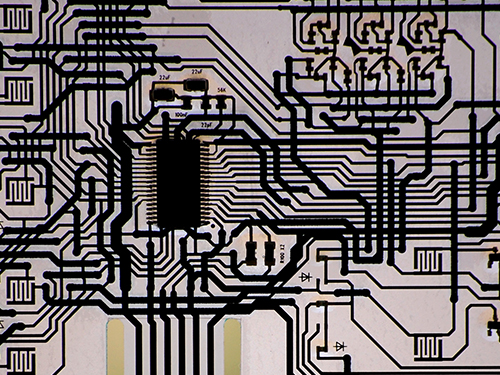
Photovoltaic
Organic Photovoltaics (OPV) involves depositing layers of organic inks on a flexible plastic film, to create environmentally-friendly, made-to-measure photovoltaic modules that produce energy. These flexible modules can be used in an infinite number of applications, making even the most complex objects self-sufficient in energy, even under artificial sunlight. The range of colours available makes the modules compatible with the design and aesthetics of products. Compared with silicon modules, they are flexible, light and semi-transparent. However, due to the nature of the materials used, their quantum efficiency is lower than that of silicon diodes, and they have a shorter lifespan, requiring excellent encapsulation.
Thin-film photovoltaics is a market that offers clear advantages over conventional crystalline silicon-based photovoltaics: lower cost and weight, flexibility and easier integration on buildings or light structures, for example (on agricultural greenhouses in the case of agrivoltaics).
Production can be carried out on a roll-to-roll basis, enabling cost structures compatible with mass markets to be achieved.
